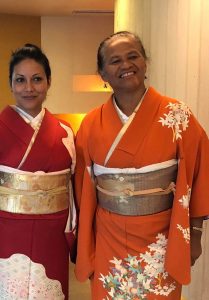
By Monica Miller
As we wrap up our time here in Tokyo, our group of journalists from the Caribbean and the Pacific are the honored guests at a tea ceremony in the city’s historic Nihonbashi district.
We also get to wear the national dress of Japan, the kimono.
Ms. Fukaumi, the owner The Koomon, a Japanese culture salon, gives us a warm welcome and asks us to name our countries.
In fluent English, she explains that the tea ceremony brings inner peace and cleansing to one’s self.

Photo: Kenton X. Chance/iWitness
It is a tradition that is more than 400 years old and is reserved for very special guests and occasions.
Our host urges us to focus on the rituals of the tea ceremony, saying that it will bring us peace and harmony.
My colleague from the Caribbean, Kim Boodram, and I are invited into the chashitsu, a special room for the tea ceremony. We will be the first guests in our group to be served tea.
A tea master, Mr. Soko Kojima, quietly prepares the tea in one corner of the room. It’s not at all like putting a bag of Lipton tea in a cup and pouring in hot water.
It’s an elaborate process. From where I’m sitting, I see a green powder, which looks like wasabi placed in a small bowl for drinking tea that’s specially chosen for the occasion. A cloth that is intricately folded is used to wipe the cup.
 There’s also a special wooden ladle used to pour hot water into the bowl.
There’s also a special wooden ladle used to pour hot water into the bowl.
I will get the first bowl of tea, but before drinking, I’m told to turn slightly to my media colleague Kim and bow my head…The gesture is one of appreciation and respect. Kim returns the bow .. agreeing that I be served first.
I also bow to the tea master in appreciation for his service.
Our host explains that the part of the tea bowl that has the most beautiful designs is turned toward the guest when the tea is served. As a sign of modesty, the recipient should turn that part of the cup away and drink from a less attractive side.
We’re to take several sips until the tea is finished. With the last sip, we’re supposed to make a slurpy sound, a sign that we like the tea.
The tea is refreshing…and I let the teamaster know my appreciation by bowing several times.
The rest of our group is served prepared tea, in turn.
 After the tea ceremony it’s time to get into our kimonos.
After the tea ceremony it’s time to get into our kimonos.
The women are shown to a room in the back while the men use the chashitsu to change.
The preparation is quite elaborate for women, as there are several pieces of clothing that make up the kimono. I count at least four undergarments with many strings tying bits and pieces together.
The strings holding the various pieces of clothing together have to be tied tightly. You wouldn’t want your kimono to come apart during ceremonies.
We get to pick from about a dozen kimonos, all with beautiful and intricate embroidery, which ones to wear. I pick a light shade of orange and a gold obi or sash to go with it.

Photo: Floyd Takeuchi
Ms. Fukaumi selects a light green sash to go on the back of my kimono, completing my traditional Japanese attire.
The men also loo smart in their kimonos. I especially like the hakama, or traditional pants, which look like a pleated skirt. All they’re missing are their samurai swords.
We pose for a few photos outside and stroll for a few blocks proudly showing off our kimono, passing by a ritzy department store that is one of Tokyo’s oldest.
The people we pass on the streets seem to appreciate seeing our group of non-Japanese women and men attired in their national dress.
News Director Monica Miller is in Japan with a group of journalists from the Caribbean and Pacific as guests of the Association for Promotion of International Cooperation and the Foreign Press Center Japan.




